MECACS Art Exhibition: Reflections of displacement and exile – Student Reflection
Shona McCallum is a 2nd year student of Arabic, Persian and International Relations at the University of St Andrews
For two weeks between May and June, 3 secluded rooms in St Andrews formed an exhibition trail through the town. ‘Reflections of Displacement and Exile’, orchestrated by the Institute of Middle East, Central Asia and Caucasus Studies (MECACS), gave a platform to 5 artists from the Middle East, Central Asia, and Caucasus region who had experience of, and whose work reflects, these title themes. These artists, from 4 countries throughout the region – Palestine, Yemen, Georgia, and Afghanistan – each lent new and unique understandings to the core topics through their work. This was an important display, which made clear the personal and human impact of the political and international relations in the region.

The display came at a time when hostility and bigotry to those experiencing displacement, exile, and asylum seeking in the UK is extremely high. As government legislation criminalizes the seeking of refuge, and media rhetoric distorts the image of refugees and other migrants, it felt particularly important that a display like this take place. Each person that attended was a heartening demonstration that people care about this cause.
In St Andrews, we are used to seeing the topics of displacement, migration, and conflict discussed in scholarly settings – from lecture halls, to academic journals, and conferences. In such themes students’ essays and staff research find focus, from many disciplines even beyond IR. These are regarded as pressing issues, especially in relation to the MECAC region.
There is an emergent and growing insistence on a more critical, informed, and empathetic approach to this type of work. This means prioritising the humans affected by these phenomena and orienting scholarship to their needs and lives. Relatedly, there is much more focus given to pursuing decolonial and empowering agendas through scholarly work. But it remains true that much of academia is inaccessible or inequitable, that academic work is rarely produced by those with displacement or refugee experience, and that biases frequently prevail. Despite the expertise held by those who have direct experience of displacement or asylum seeking, they are often unable to attain legitimacy and prestige in the field – or are even criticised as lacking impartiality themselves, as a result of their background.
Thus, the exhibition represented a necessary counter-balance. This was especially felt in St Andrews which is a remote and extremely privileged and academic place. The artists displayed the emotional and complicated impacts of exile, displacement, and war in a visual and deeply personal way. Of course, the pieces which were gathered for the display were not made with the intention of being in a university exhibition; they were originally an outlet for the artists themselves. They therefore contained something which was authentic, detailed, and unique in a way scholarly works often lack. Most importantly, the pieces spoke with the clear and unfiltered voices of their artists, and reflected their own experiences of exile and displacement, on their own terms.
Therefore, varied and complicated emotions and situations were explored in the works. The artists were able to capture not only the pain and panic of the displacement experience – such as in Qusai Aljaradat’s long-exposure photo series depicting a Syrian woman struggling to put on a life-jacket – but also the beauty, quirks, and personal stories of their homes.
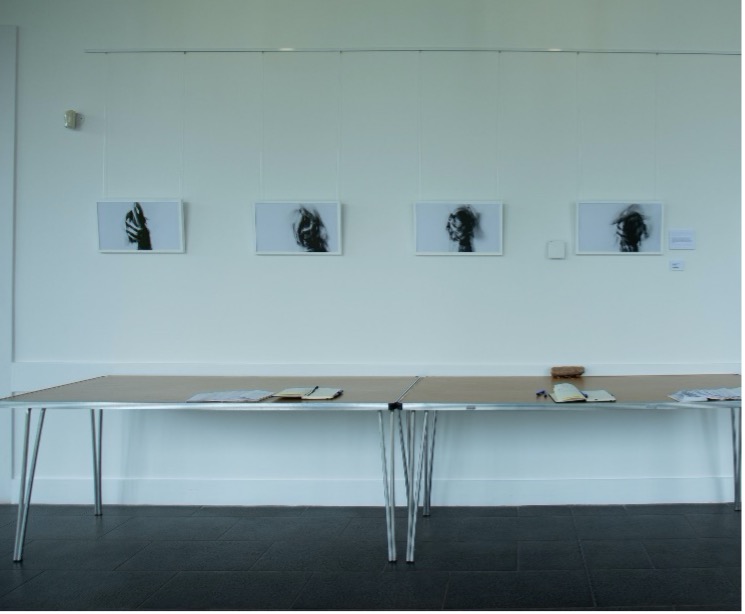
In her striking, vibrant piece ‘Home in Jaffa’, Heba Mohamad portrays her grandparents’ house. The creation of the Israeli state in 1948 meant her grandparents were expelled from this house, her family home, as were many Palestinian families. She reflected, “I express myself through my paintings, such as my house in Jaffa, my house, which I cannot visit”. The house is surrounded by blooming blossoms and the bright blue door is ajar, open and waiting for its original inhabitants, inviting them home. This piece forms a part of the Palestinians’ tradition of preserving their homeland through art and, notably, poetry and literature. For those who have been displaced – often multiple times – from their homes, whose land is occupied, and whose culture is being stripped away, this is a way to resist, reclaim, and return.
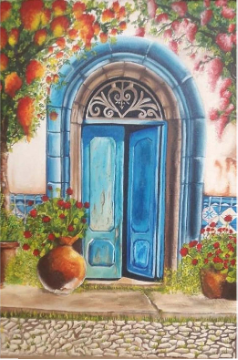
The heartache of estrangement from one’s native place was aptly conveyed in the pieces. A further layer was added, since the artists have all become (re)settled in the UK, a place which represents complicated emotions – as David Giunashvili demonstrated with his friend’s caged passport, political bureaucracy trapping him in a place of safety. For many refugees, and others who have left their homes, the country of asylum is bittersweet. Equally, the MECAC region is met with mixed feelings, as home becomes the place to flee. The display itself was a poignant reminder of these paradoxical emotions.
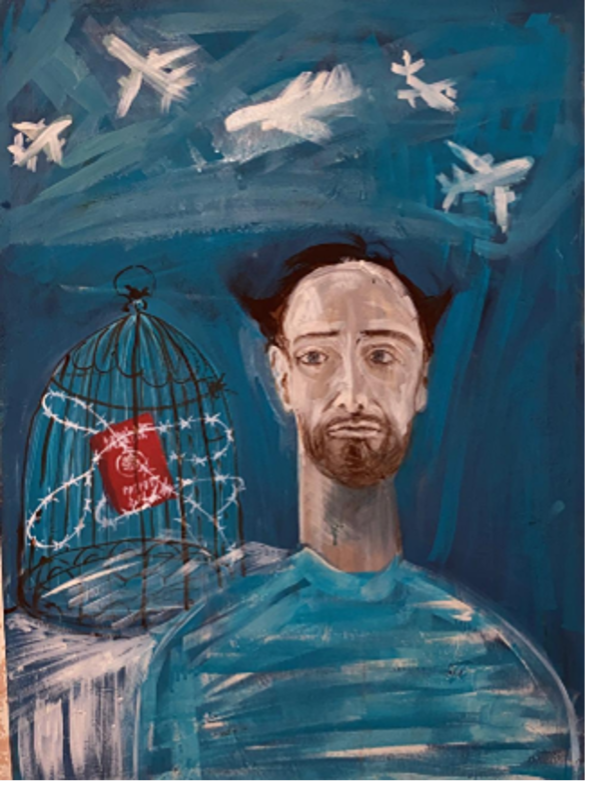
For these artists, unlike those who haven’t known the pain of displacement and exile, the process of creating their art was a process of recreating their homes – home cultures, home cities, and homelands. In the words of one of our artists, Shatha Altowai who has resettled in Scotland from Yemen, “the concept of a homeland now only exists in my artwork and the sense of security I feel when I enter my own creative world”. Thus, the pieces in the display were not just reflections, but places of refuge.
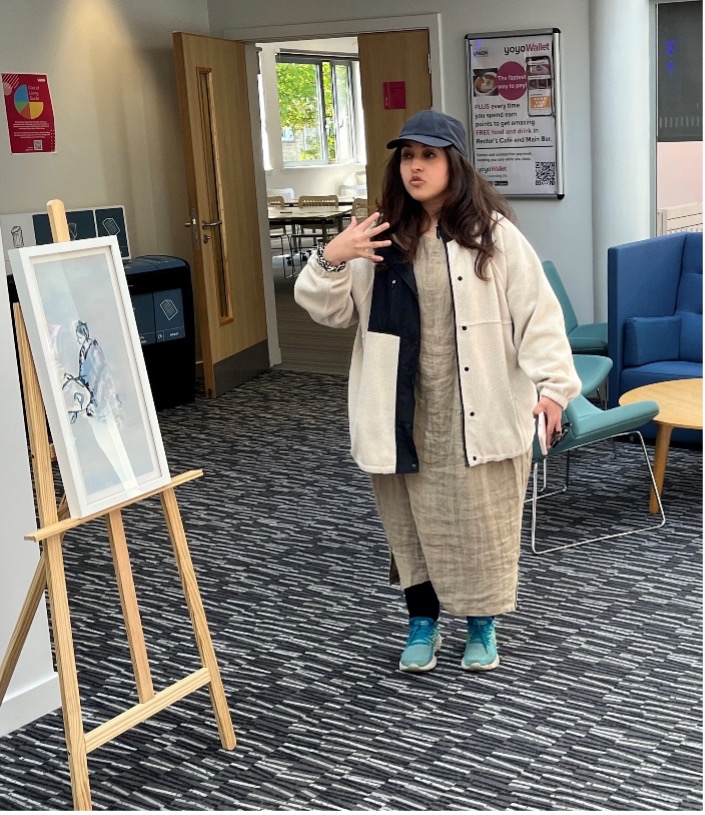
While it was beautiful to see experiences from the region, embedded in pain, transformed into art, it feels important to remember that these artworks do not justify or ameliorate the process which made them. In other words, these talented artists and their works would be valuable even if they had not been rooted in exile and displacement; and that the MECAC region and these artists can be seen more expansively than just through reflecting these themes for our St Andrews audience. It is necessary to balance two truths: that it was moving and impressive to see these artists reflect on exile and displacement, but that these experiences were painful, difficult, and damaging.
In a recently published article, Dr Malaka Shwaikh from the School of IR at St Andrews reflected on the discourse of ‘resilience’ and how it is often, damagingly, applied to marginalized communities[1]. Her work focused especially on Palestinians, and Dr Shwaikh is in fact Palestinian herself. In this passionate and engaging article, she explained how expectations of resilience for those who have already faced violence, occupation, or displacement is a challenge additional to these experiences; “resilience is a political tool used by global development organizations to pass the burden of coping with violence to individuals, instead of tackling the root causes of (structural) violence.” This idea of ‘resilience’ and ‘coping’, of being able to constantly transform trauma into something extraordinary, denies people their humanity and their need for vulnerability. At the same time, it absolves the powerful, wealthy, and privileged (such as most of us in St Andrews) from examining and dismantling the power systems which oppress them.
She reminds us, “They do not choose resilience. Palestinians I met, during and outside my fieldwork, are tired of being objects of work that expect their constant strength.” While I hope, and do not think, this display imposed superhuman expectations of strength or fortitude, it is important to bear this in mind. We can laud the artists in the display, and simultaneously appreciate that if many who have gone through experiences of displacement cannot transmute their experiences into art, they are no less worthy of care and welcome.
In our artists’ recollection of their worlds – the strength and vulnerability people exhibit in conflict and occupation in the MECAC region – there is also the conjuring of a future world where art from the region can be just art, and ‘refugee artists’ are just artists. I feel that in our scholarship and in our lives, we must find places for hope and joy in discussions of the MECAC region and those living there and in its diaspora.
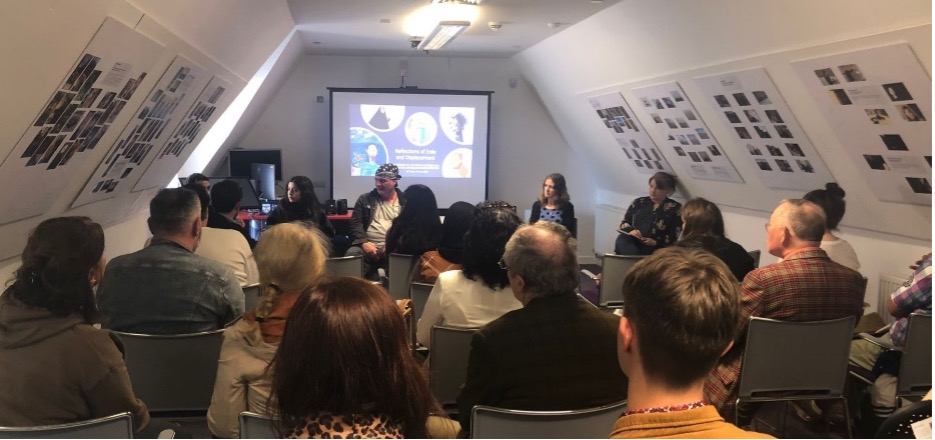
Some wonderful media and social media projects, which also showcase MECAC creativity in multifaceted ways, include
- Kerning Cultures podcast network (‘stories of the Middle East, North Africa, and the spaces in between’)
- Mathqaf – a social media group which collates and displays art from West Asia and North Africa (@mathqaf on Instagram)
- Middle East Archive – a photo-archive which collects photos from across the MENA region, on social media and in books (@middleastarchive on Instagram)
- Telah Archive – which collects photos and moments from Iranian and Afghan heritage, on social media (@telaharchive on Instagram)
And there are many more such emerging platforms which lend new perspectives on beauty, culture, archiving, and art in the region. These are an essential reminder that suffering is not always necessary for beauty, and that MECAC beauty is worthy without such suffering.
[1] ‘Beyond Expectations of Resilience: Toward a Language of Care’, Dr Malaka Shwaikh, Global Studies Quarterly Volume 3 Issue 2 April 2023. https://academic.oup.com/isagsq/article/3/2/ksad030/7198303?login=false